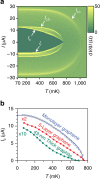Ultimately short ballistic vertical graphene Josephson junctions
- PMID: 25635386
- PMCID: PMC4317505
- DOI: 10.1038/ncomms7181
Ultimately short ballistic vertical graphene Josephson junctions
Abstract
Much efforts have been made for the realization of hybrid Josephson junctions incorporating various materials for the fundamental studies of exotic physical phenomena as well as the applications to superconducting quantum devices. Nonetheless, the efforts have been hindered by the diffusive nature of the conducting channels and interfaces. To overcome the obstacles, we vertically sandwiched a cleaved graphene monoatomic layer as the normal-conducting spacer between superconducting electrodes. The atomically thin single-crystalline graphene layer serves as an ultimately short conducting channel, with highly transparent interfaces with superconductors. In particular, we show the strong Josephson coupling reaching the theoretical limit, the convex-shaped temperature dependence of the Josephson critical current and the exceptionally skewed phase dependence of the Josephson current; all demonstrate the bona fide short and ballistic Josephson nature. This vertical stacking scheme for extremely thin transparent spacers would open a new pathway for exploring the exotic coherence phenomena occurring on an atomic scale.
Figures









References
-
- Likharev K. K. Superconducting weak links. Rev. Mod. Phys. 51, 101–159 (1979).
-
- Tinkham M. Introduction to Superconductivity Dover (2004).
-
- Doh Y.-J. et al. Tunable supercurrent through semiconductor nanowires. Science 309, 272–275 (2005). - PubMed
-
- Jarillo-Herrero P., van Dam J. A. & Kouwenhoven L. P. Quantum supercurrent transistors in carbon nanotubes. Nature 439, 953–956 (2006). - PubMed
-
- Heersche H. B., Jarillo-Herrero P., Oostinga J. B., Vandersypen L. M. K. & Morpurgo A. F. Bipolar supercurrent in graphene. Nature 446, 56–59 (2007). - PubMed
Publication types
LinkOut - more resources
Full Text Sources
Other Literature Sources

